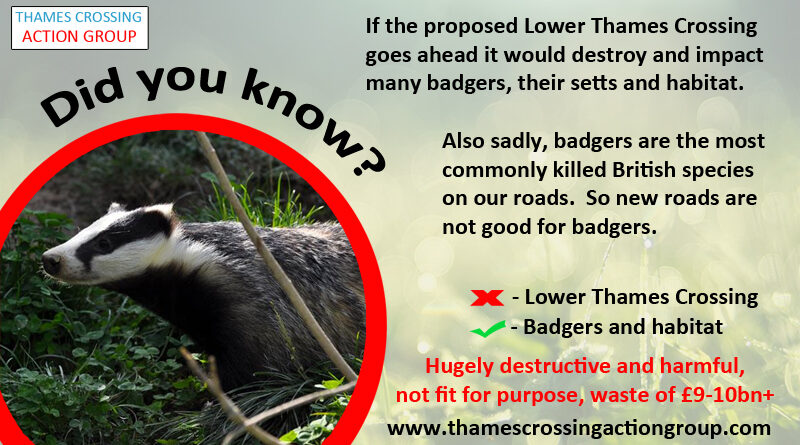LTC impacts on badgers
As we know the proposed Lower Thames Crossing would be hugely destructive and harmful on so many levels, and that includes impacts on badgers.
Some basic badger facts
Badgers are one of the UK’s native mammals, and have been around since the Ice Age!
They are territorial creatures, meaning they have their set areas to live, forage etc and stick to their own patch, and will defend it against other badger clans!
They spend most of their time underground in their setts, which are underground tunnels and chambers.
Badgers can shift a cubic meter of soil in a night (they really are the JCB’s of the animal world!) they can dig a new home in a night.
It is normal for a badger clan to have a main sett, and an outlying sett which the males are often forced to use when the female kicks them out while she has cubs.
In some areas badgers will have summer and winter residence, as well as bolt holes for when they are forced to go further away from home for food.
They do not hibernate. Badger cubs are normally born around February, and generally tend to stay in the sett until around April.
They are nocturnal which is why most of the time people don’t see that much of them!
They forage most of the night for plants and animals to eat, earthworms are a favourite!
Badgers use the same well worn paths to access foraging grounds for generations.
Badgers and their setts are protected under the Protection of Badgers Act 1992.
Works to badger setts (involving exclusion or works likely to result in disturbance) can generally only take place between 1st July and 30th November.
Where artificial setts are required, as is the case where the loss of a main sett is unavoidable, these structures should be constructed at least 6 months ahead of any works affecting the badger setts.
Sadly, badgers are the most commonly killed British species on our roads. Learn more in the Badger Trust video.
LTC impacts on badgers
As well as directly putting badgers and their setts are risk, the proposed LTC would have a negative impact on the habitat where badgers forage and live. And as we’ve mentioned above a new road increases the likelihood of more badger road deaths.
Whilst NH/LTC keep up the propaganda on their ‘green’ bridges, we have seen no evidence on how badgers (and other creatures) will be protected and any provisions put in place to stop them getting onto the LTC and killed. For instance the ‘green’ bridge at North Road, South Ockendon would be in an area known for badgers. What would be in place to encourage the badgers to use the ‘green’ bridge to get from A to B rather than going down the service/emergency vehicle access routes and/or embankments and on to the busy LTC?
We’d also be interested to know how recently NH/LTC have carried out wildlife surveys, since surveys over a year old are often considered out of date, due to how quickly new setts can be created by these amazing creatures!
What we’ve managed to find out through consultation materials
LTC impacts on badgers
You can scroll through using the arrows
If you are having any issues with viewing our response above it can also be downloaded as a pdf file here.
Related
Badger Trust – Exists to promote and enhance the welfare, conservation and protection of badgers, their setts, and their habitats.
Essex Badger Protection Group – A group of voluntary members throughout Essex whose common interest is the protection of badgers
West Kent Badger Group – A group of volunteers whose key role is to protect badgers and to promote their welfare in West Kent

